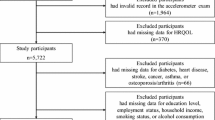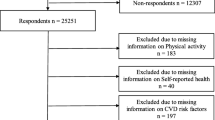Abstract
Sedentary lifestyles have been linked to higher rates of stroke, hypertension, depression, certain types of cancers, and cardiovascular disease, and increased risk of mortality. The link between physical inactivity and health has led to research on how physical activity (PA) interventions might improve health-related quality of life (HRQoL). Estimates of HRQoL improvements are typically focused on targeted at-risk groups, however. Given that almost half of the U.S. adult population is physically inactive, it would be helpful to broaden our understanding of how PA relates to quality of life for the population at large. In this study, we calculated the HRQoL gains attributable to PA across three nationally representative data sets that use different quality of life measures, and assessed the reliability in the results. The data sets used were the Medical Expenditure Panel Survey (MEPS), the Behavioral Risk Factor Surveillance System (BRFSS), and the National Health Interview Survey (NHIS). Quasi-likelihood regression modeling with a beta distribution was used to generate the estimates. We found mean HRQoL scores were very similar across the three data sets and the estimated HRQoLs gained from PA varied only slightly, suggesting that all three provide reliable estimates for the general population.
Similar content being viewed by others
Notes
Though ideally we would like to control for diet and smoking in our analyses, the data are not conducive to doing so. For example, the BRFSS survey only includes questions about smoking for a subset of the survey years, thus use of this information would lead to the elimination of a substantial number of observations. On the other hand, BRFSS regularly asks questions related to diet, whereas NHIS and MEPS surveys do not. As we wanted to keep the control variables in our regression analysis as close to one another as possible, we did not include smoking or diet in our analyses.
We used the general rule of thumb for detecting multicollinearity, which is a condition index over 5 and two proportion of variation figures greater than 0.5.41
All three surveys include sample weights that adjust for the sample design and survey non-response.
References
Abell, J., Hootman, J., Zach, M., Moriarty, D., & Helmick, C. (2005). Physical activity and health related quality of life among people with arthritis. Journal of Epidemiology and Community Health, 59(5), 380–385.
Anokye, N., Trueman, P., Green, C., Pavey, T., & Taylor, R. (2012). Physical activity and health related quality of life. BMI Public Health, 12, 624.
Basu, A., & Manca, A. (2012). Regression estimators for generic health-related quality of life and quality-adjusted life years. Medical Decision Making, 32(1), 56–69.
Belsley, D., Kuh, E., & Welsch, R. (2004). Regression diagnostics: Identifying influential data and sources of collinearity. Hoboken, NJ: Wiley.
Bize, R., Johnson, J., & Plotnikoff, R. (2007). Physical activity level and health-related quality of life in the general adult population: A systematic review. Preventive Medicine, 45(6), 401–415.
Brazier, J. E., Yang, Y., Tsuchiya, A., & Rowen, D. L. (2010). A review of studies mapping (or cross walking) non-preference based measures of health to generic preference-based measures. The European Journal of Health Economics, 11(2), 215–225.
Brown, D., Balluz, L., Heath, G., Moriarty, D., Ford, E., Giles, Q., & Mokdad, A. (2003). Associations between recommended levels of physical activity and health-related quality of life. Findings from the 2001 behavioral risk factor surveillance (BRFSS) survey. Preventive Medicine, 37(5), 520–528.
Campbell, J., Ghushchyan, V., McQueen, R., Cahoon-Metzger, S., Livingston, T., Vollmer, T., Corboy, J., Miravalle, A., Schreiner, T., Porter, V., & Nair, K. (2014). Burden of multiple sclerosis on direct, indirect costs, and quality of life: National US estimates. Multiple Scloerosis and Related Disorders, 3(2), 227–236.
Carlson, S., Fulton, J., Pratt, M., Yang, Z., & Adams, E. (2015). Inadequate physical activity and health care expenditures in the United States. Progress in Cardiovascular Diseases, 57(4), 315–323.
Centers for Disease Control and Prevention (2015). How much physical activity do adults need? Atlanta: CDC. Retrieved June 18, 2015. Available at: https://www.cdc.gov/physicalactivity/basics/adults/
Centers for Disease Control and Prevention (2017). Behavioral Risk Factor Surveillance Survey: Survey Data and Documentation. Retrieved August 1, 2016. Available at: https://www.cdc.gov/brfss/data_documentation/index.htm.
Centers for Disease Controls and Preventions (2011). Health-related quality of life. Atlanta: CDC. Retrieved January 2016. Available at: (http://www.cdc.gov/hrqol/concept.htm).
Cherepanov, D., Palta, M., Fryback, D., & Robert, S. (2010). Gender differences in health-related quality-of-life are partly explained by sociodemographic and socioeconomic variation between adult men and women in the US: Evidence from four US nationally representative data sets. Quality of Life Research, 19(8), 1115–1124.
Erickson, P. (1998). Evaluation of a population-based Mesuare of quality of life. Quality of Life Research, 7(2), 101–114.
Erickson, P., Wilson, R., Shannon, I. (1995). Years of Healthy Life. Statistical Notes, 7. Centers for Disease Control and Prevention/National Center for Health Statistics.
EuroQol Group. (1996). EuroQol: A new facility for the measurement of health-related quality of life. Health Policy, 37, 53–72.
Feeny, D., Spritzer, K., Liu, H., Ganiats, T., Kaplan, R., Palta, M., & Fryback, D. (2012). Agreement about identifying patients who change over time: Cautionary results in cataract and heart failure patients. Medical Decision Making, 32(2), 273–286.
Fontaine, K., & Barofsky, I. (2001). Obesity and health-related quality of life. Obesity Reviews, 2(3), 173–182.
Freelove-Charton, J., Bowles, H., & Hooker, S. (2007). Health-related quality of life by level of physical activity in arthritic older adults with and without activity limitations. Journal of Physical Activity and Health, 4(4), 481–494.
Fryback, D., Dunham, N., Palta, M., Hanmer, J., Buechner, J., et al. (2007). US norms for six generic health-related quality-of-life indexes from the National Health Measurement Study. Medical Care, 45(12), 1162–1170.
Haddix, A., Teutsch, S., & Corso, P. (2003). Prevention effectiveness: A guide to decision analysis and economic evaluation. New York, NY: Oxford University Press.
Hanmer, J., Lawrence, W., Anderson, J., Kaplan, R., & Fryback, D. (2006). Report of nationally representative values for the noninstitutionalized US adult population for 7 health-related quality-of-life scores. Medical Decision Making, 26, 391–400.
Hanmer, J., Hays, R., & Fryback, D. (2007). Mode of administration is important in US national estimates of health-rlated quality of life. Medical Care, 45(12), 1171–1179.
Heath, G., & Brown, D. (2009). Recommended levels of physical activity and health-related quality of life among overweight and obese adults in the United States, 2005. Journal of Physical Activity and Health, 6(4), 403–411.
Hunger, M., Döring, A., & Holle, R. (2012). Longitudinal beta regression models for analyzing health-related quality of live scores over time. BMC Medical Research Methodology, 12, 144.
Jia, H., & Lubetkin, E. (2008). Estimating EuroQol EQ-5D scores from population healthy days data. Medical Decision Making, 28(4), 491–499.
Jia, H., & Lubetkin, E. (2010). Obesity-related quality-adjusted life years lost in the US from 1993 to 2008. American Journal of Preventive Medicine, 39(3), 220–227.
Jia, H., & Lubetkin, E. (2014). Comparing quality-adjusted life expectancy at different levels of physical activity. Journal of Physical Activity and Health, 11(2), 278–284.
Jia, H., Lubetkin, E., Moriarty, D., & Zack, M. (2007). A comparison of healthy days and EuroQol EQ-5D measures in two US adult samples. Applied Research in Quality of Life, 2(3), 209–221.
Kaplan, R., Anderson, J., & Ake, C. (2001). Gender differences in quality-adjusted life expectancy: Results from the National Health Interview Survey. Clinical Journal of Women’s Health, 1(4), 191–198.
Kaplan, R., Tally, S., Hays, R., Feeny, D., Ganiats, T., Palta, M., & Fryback, D. (2011). Five preference-based indexes in cataract and heart failure patients were not equally responsive to change. Journal of Clinical Epidemiology, 64(5), 497–506.
Kennedy, J., Roll, J., Schraudner, T., Murphy, S., & McPherson, S. (2014). Prevalence of persistent pain in the U.S. adult population: New data from the 2010 National Health Interview Survey. The Journal of Pain, 15(10), 979–984.
Livingston, E., & Ko, C. (2002). Use of the health and activities limitation index as a meausre of quality of life in obesity. Obesity Research, 10(8), 824–832.
Luo, N., Johnson, J., Shaw, J., Feeny, D., & Coons, S. (2005). Self-reported health status of the general adult U.S. population as assessed by the EQ-5D and health utilities index. Medical Care, 43, 1078–1086.
Moriarty, D., Zack, M., Kobau, R. (2003). The Centers for Disease Control and Prevention’s Healthy Days Measures - Population tracking of perceived physical and mental health over time. Health and Quality of Life Outcomes, 137.
National Center for Health Statistics (NCHS): National Health Interview Survey. Centers for Disease Control and Prevention (2017). Retrieved August 1, 2016. Available at: https://www.cdc.gov/nchs/nhis/index.htm.
Neumann, P., Sanders, G., Russell, L., Siegal, J., & Ganiats, T. (2017). Cost-effectiveness in health and medicine. Second edition. New York, NY: Oxford University Press.
Nord, E. (1999). Cost-value analysis in health care: Making sense out of QALYs. New York, NY: Cambridge University Press.
Räsänen, P., Roine, E., Sintonen, H., Semberg-Konttinen, V., Ryynänen, O. P., & Roine, R. (2006). Use of quality-adjusted life years for the estimation of effectiveness of health care: A systematic literature review. International Journal of Technology Assessment in Health Care, 22(2), 235–241.
Reenan, M., Janssen, B. (2015). EQ-5D-5L User Guide: Basic information on how to use the EQ-5D-5L instrument. Version 2.1.
Rejeski, W., Brawley, L., & Shumaker, S. (1996). Physical activity and health-related quality of life. Exercise and Sport Sciences Reviews, 24, 71–108.
Suzuki, R., Wallace, P., & Small, E. (2015). Race, health-related quality of life and colorectal cancer screening rates in the national health interview survey. American Journal of Health Behavior, 39(1), 132–139.
Roux, L., Pratt, M., Tengs, T., Yore, M., Yanagawa, T., Van Den Bos, J., et al. (2008). Cost effectiveness of a community-based physical activity interventions. American Journal of Preventive Medicine, 35(6), 578–588.
Shaw, J., Johnson, J., & Coons, S. (2005). US valuation of the EQ-5D health states: Development and testing of the D1 valuation model. Medical Care, 43(3), 203–220.
Stewart, A. L., Hays, R. D., Wells, K. B., Rogers, W. H., Spritzer, K. L., & Greenfield, S. (1994). Long-term functioning and well-being outcomes associated with physical activity and exercise in patients with chronic conditions in the medical outcomes study. Journal of Clinical Epidemiology, 47(7), 719–730.
Sullivan, P., Smith, K., Ghushchyan, V., Globe, D., Lin, S., & Globe, G. (2013). Asthma in USA: Its impact on health-related quality of life. The Journal of Asthma, 50(8), 891–899.
Sun, K., Song, J., Manheim, L., Chang, R., Kwoh, K., Semanik, P., Eaton, C., et al. (2014). Relationship of meeting physical activity guidelines with quality adjusted life-years. Seminars in Arthritis and Rheumatism, 44(3), 264–270.
Trust for America’s Health and the Robert Wood Johnson Foundation. The state of obesity: Physical inactivity in the United States. (2017). Available at: https://stateofobesity.org/physical-inactivity/. Accessed December 3, 2017.
Warburton, D., Nicol, C., & Bredin, S. (2006). Health benefits of physical activity: The evidence. Canadian Medical Association Journal, 174(6), 801–809.
Weaver, K., Forsythe, L., Reeve, B., Alfano, C., Rodriguez, J., Sabatino, S., Hawkins, N., & Rowland, J. (2012). Mental and physical health-related quality of life among U.S. cancer survivors: Population estimates from the 2010 National Health Interview Survey. Cancer Epidemiology, Biomarkers & Prevention, 21(11), 2108–2117.
Yin, S., Njai, R., Barker, L., Siegel, P., & Liao, Y. (2016). Summarizing health-related quality of life (HRQOL): Development and testing of a one-factor model. Populaiton Health Metrics, 1422.
Funding
This study was funded in part by Idaho State University with a Summer Research Grant for Iris Buder.
Author information
Authors and Affiliations
Corresponding author
Ethics declarations
Conflict of Interest
Iris Buder declares that she has no conflict of interest. Cathleen Zick declares that she has no conflict of interest. Norman Waitzman declares that he has no conflict of interest.
Ethical Approval
This article does not contain any studies with human participants performed by any of the authors.
Rights and permissions
About this article
Cite this article
Buder, I., Zick, C. & Waitzman, N. The Contribution of Physical Activity to Health-Related Quality of Life: New Population Estimates from National Survey Data. Applied Research Quality Life 15, 55–71 (2020). https://doi.org/10.1007/s11482-018-9665-5
Received:
Accepted:
Published:
Issue Date:
DOI: https://doi.org/10.1007/s11482-018-9665-5




